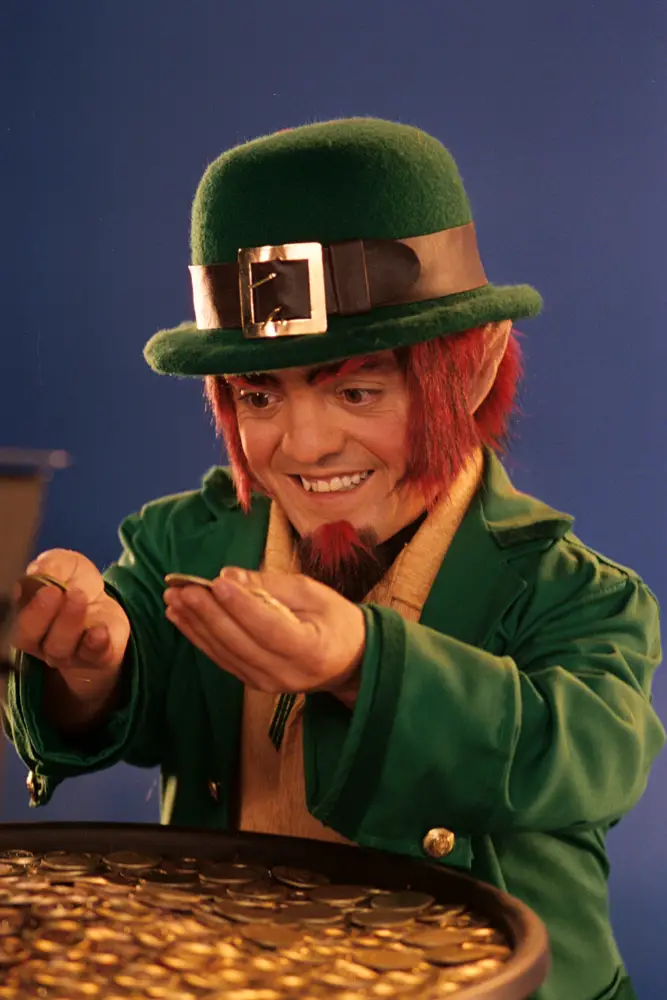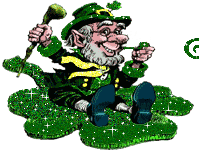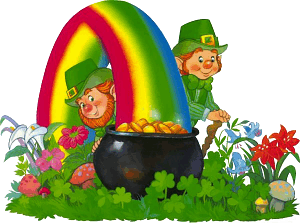
A brief history....
The name leprechaun may have derived from the Irish leath brogan or shoemaker, although its origins may lie in luacharma'n Irish for pygmy.Alternative spellings in English have included lubrican, leprehaun, and lepreehawn.The leprechaun originally had a different appearance depending on where in Ireland he was found. Prior to the 20th century, it was generally held that the leprechaun wore red, not green.

The leprechaun 'family' appears split into two distinct groups - leprechaun and cluricaun. Although the leprechaun has been described as Ireland's national fairy, this name was originally only used in the north Leinster area. Variants include lurachmain, lurican, lurgadhan.

If caught by a mortal, he will promise great wealth if allowed to go free. He carries two leather pouches. In one there is a silver shilling, a magical coin that returns to the purse each time it is paid out. In the other he carries a gold coin which he uses to try and bribe his way out of difficult situations. This coin usually turns to leaves or ashes once the leprechaun has parted with it.

If ever captured by a human, the Leprechaun has the magical power to grant three wishes in exchange for their release. Popular depiction shows the Leprechaun as being no taller than a small child, with a beard and hat, although they may originally have been perceived as the tallest of the mound-dwellers (the Tuatha Dé Danann).

Among the most popular of beliefs about leprechauns is that they are extremely wealthy and like to hide their gold in secret locations, which can only be revealed if a person were to actually capture and interrogate a leprechaun for its money. Another popular belief is that you may find a leprechaun and his pot of gold at the end of a rainbow.

These apparently aged, diminutive men are frequently to be found in an intoxicated state, caused by home-brew poteen. However they never become so drunk that the hand which holds the hammer becomes unsteady and their shoemaker's work affected.

The leprechaun 'family' appears split into two distinct groups - leprechaun and cluricaun. Cluricauns may steal or borrow almost anything, creating mayhem in houses during the hours of darkness, raiding wine cellars and larders. They will also harness sheep, goats, dogs and even domestic fowl and ride them throughout the country at night. Although the leprechaun has been described as Ireland's national fairy, this name was originally only used in the north Leinster area. Variants include lurachmain, lurican,lurgadhan.

This dress could vary by region, however. In McAnally's account there were differences between leprechauns or Logherymans from different regions:
- The Northern Leprechaun or Logheryman wore a "military red coat and white breeches, with a broad-brimmed, high, pointed hat, on which he would sometimes stand upside down".
- The Lurigadawne of Tipperary wore an "antique slashed jacket of red, with peaks all round and a jockey cap, also sporting a sword, which he uses as a magic wand".
- The Luricawne of Kerry was a "fat, pursy little fellow whose jolly round face rivals in redness the cut-a-way jacket he wears, that always has seven rows of seven buttons in each row".
- The Cluricawne of Monaghan wore "a swallow-tailed evening coat of red with green vest, white breeches, black stockings," shiny shoes, and a "long cone hat without a brim," sometimes used as a weapon.

Leprechauns are the owners of Shamrock and the four-leaf clover garden. In Irish tradition the Shamrock represents “the holy trinity”: one leaf for the Father, one for the Son and one for the Holy Spirit. For the four-leaf clover, it is a universally accepted symbol of good luck. One leaf is for HOPE; the second is for FAITH; the third is for LOVE; and the fourth for luck .

There is no mention of female leprechauns in traditional Irish legend, so there are different theories as to how they come about. Perhaps they are defective offspring of other fairies, or maybe they're the products of unions between fairies & humans.

www.leprechaunmuseum.ie/
The National Leprechaun Museum is a museum dedicated to leprechauns which has operated between Jervis Street and Middle Abbey Street (on 1 Jervis Street) in Dublin, Ireland, since 10 March 2010.

The Leprechaun is an old bachelor, who successfully resists all efforts of fairy mothers who attempt to marry him to their young, beautiful fairy daughters. This may explain why Leprechauns are always seen alone, and why there are never sightings of female Leprechauns.
So, basically, he is just like every other man...he is happy as long as he is fed, gets mad when he isn't, drinks from the milk carton, and doesn't want to get married. (I am just joking on this part)



No comments:
Post a Comment